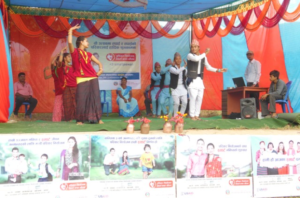Making Smart Choices Easy: Incorporating Behavioral Economics into a National Campaign in Nepal

One of several Smart Couple campaign advertisements.
The “Smart Jeewan” (Smart Couple) campaign in Nepal, a joint effort between the Health Communication Capacity Collaborative (HC3) and Nepal’s Ministry of Health and Population (MOHP), has received recognition for its creative approach to promote healthy timing and spacing of pregnancies (HTSP), including an award for excellence in rural marketing. The Smart Couple campaign was so popular that the Nepal MOHP adopted it as the national Family Planning theme and the National Health Education Information and Communication center has committed to continue it after the project closes this year.
Underlying this success is an approach that uses not only creative, strategic and evidence-based social and behavior change communication (SBCC), but also behavioral economics. Focusing on young couples, whose contraceptive use is lower than older couples, HC3 used formative research and pretesting to identify the deep-seated motivations that drive fertility management behavior. It started with the fundamental ‘why’ behind fertility management behavior. In the words of respondents, fertility management provides their children with better care, a good home and education. In short, they wanted their children (and themselves) to survive and thrive both socially and physically. With these insights into couples’ self- and parental investment motivations, HC3 designed approaches that used behavioral economics concepts and seamlessly incorporated them into a national campaign to promote delay of first birth, postpartum family planning and safe spacing of pregnancy.

A drama performance at a welcome event for migrants and newlyweds.
The campaign set out to build on deep-seated motivations for fertility management and to make the means to that end—that is, the choice and use of contraceptive methods—easier for young couples. According to behavioral economics, choices that require less deliberation have a “lower cognitive cost” and people are more likely to make them. For the Smart Jeewan campaign, priming, heuristics (mental shortcuts we use to make decisions) and reminders reduced the cognitive cost of choosing family planning methods.
Priming
In Nepal, the English word “Smart” is part of local vernacular, associated with global thinking and new technology. Young Nepali men and women use “Smart Couple” favorably to describe a relationship with mutual understanding, a bright future and intelligence. This became apparent when HC3 pretested campaign materials with nearly 60 men and women from eight districts. HC3 and the MOHP then positioned family planning as part of smart living—Parivar Niyojan, Smart Bancha Jeewan (Family Planning Makes a Smart Life). Media ads and printed materials use headings such as “For a Bright Future and Smart Life: Use Family Planning to Space Your Children.” By focusing on the familiar word “Smart,” the campaign primed the audience to associate family planning with intelligence and potential. This association builds on aspirations that young couples already have and reduced the need to deliberate on the decision.

These seven leaflets were developed as job aids to be used by community health workers communicating with young couples.
Heuristics
Behavioral scientists have found that people often rely on heuristics—mental shortcuts to make decisions under constraints. When people see behaviors modeled for them, they develop a mental image that reduces the cognitive cost of doing that behavior. The Smart Jeewan campaign created a series of printed materials and television spots that modeled the most recommended and appropriate contraceptive methods for the various life stages: newlyweds, before the first child, after delivery and between children. These mental images allowed the intended audience to see themselves making similar contraceptive decisions at these stages.
Reminders
Formative research also revealed that many husbands were migrant workers and contraceptive use depended on whether husbands were away or cohabitating. Ninety-two percent of women cited “husband away” as reason for not using contraception. This means that even if a young married couple made the decision to use a contraceptive method, they might not remember to restart contraception each homecoming. The Smart Jeewan campaign held festive “migrant welcome events” to time homecomings with reminders to use contraceptive methods. These events made it easier for young couples to stay committed to family planning.
Final results on the impact on family planning use will be available soon.
Follow the Springboard Discussion on Behavioral Economics and SBCC.







Leave a Reply
Want to join the discussion?Feel free to contribute!